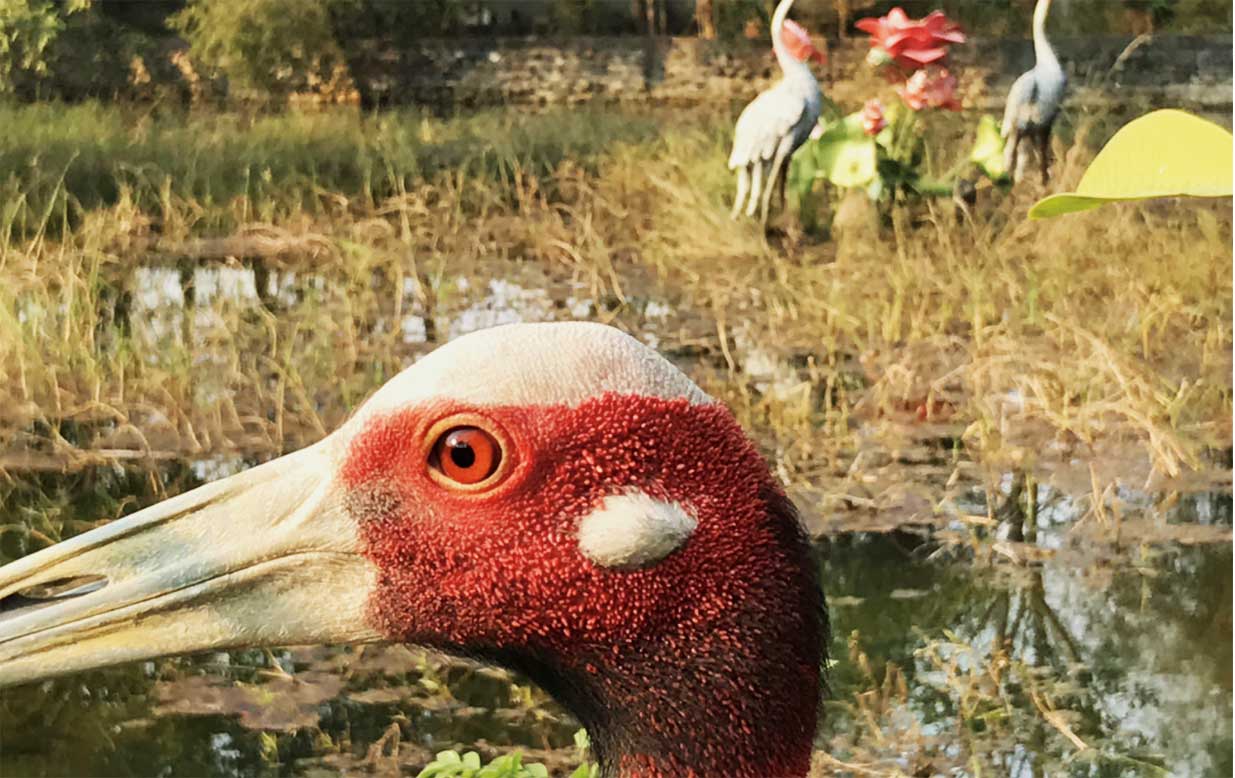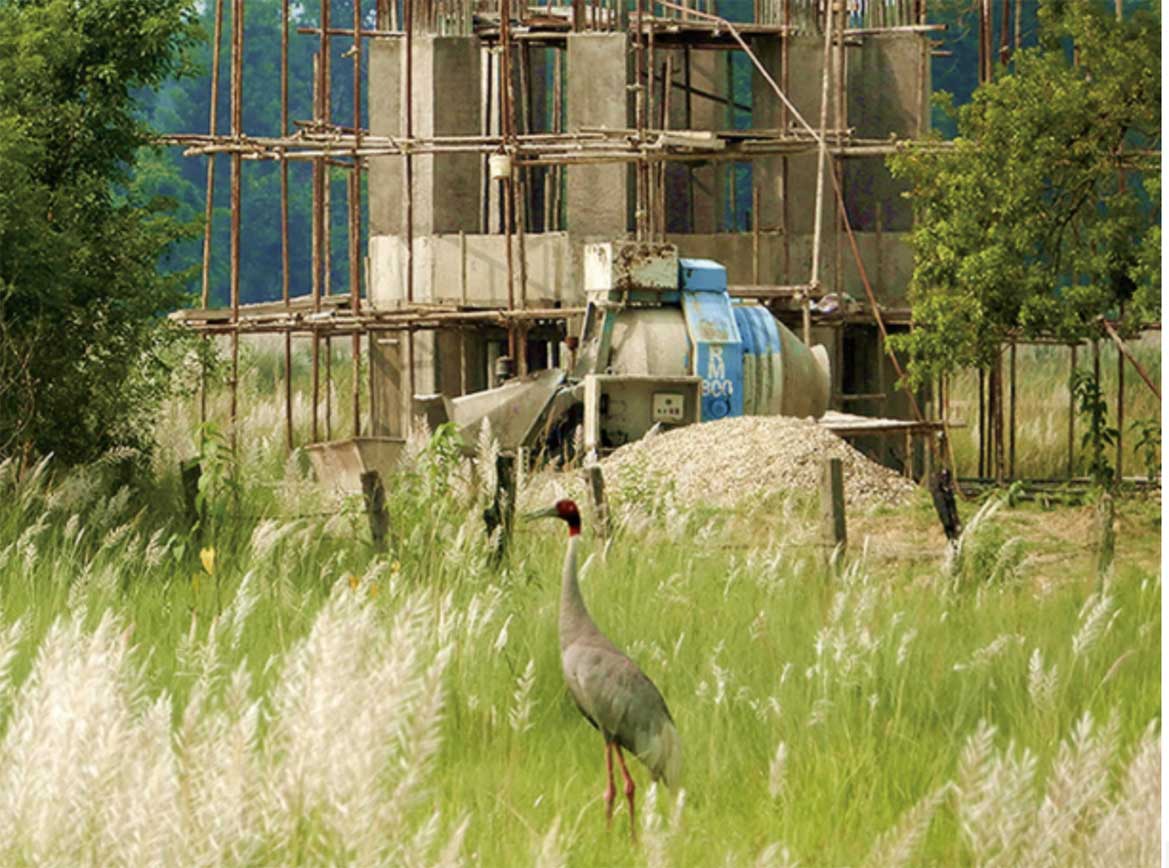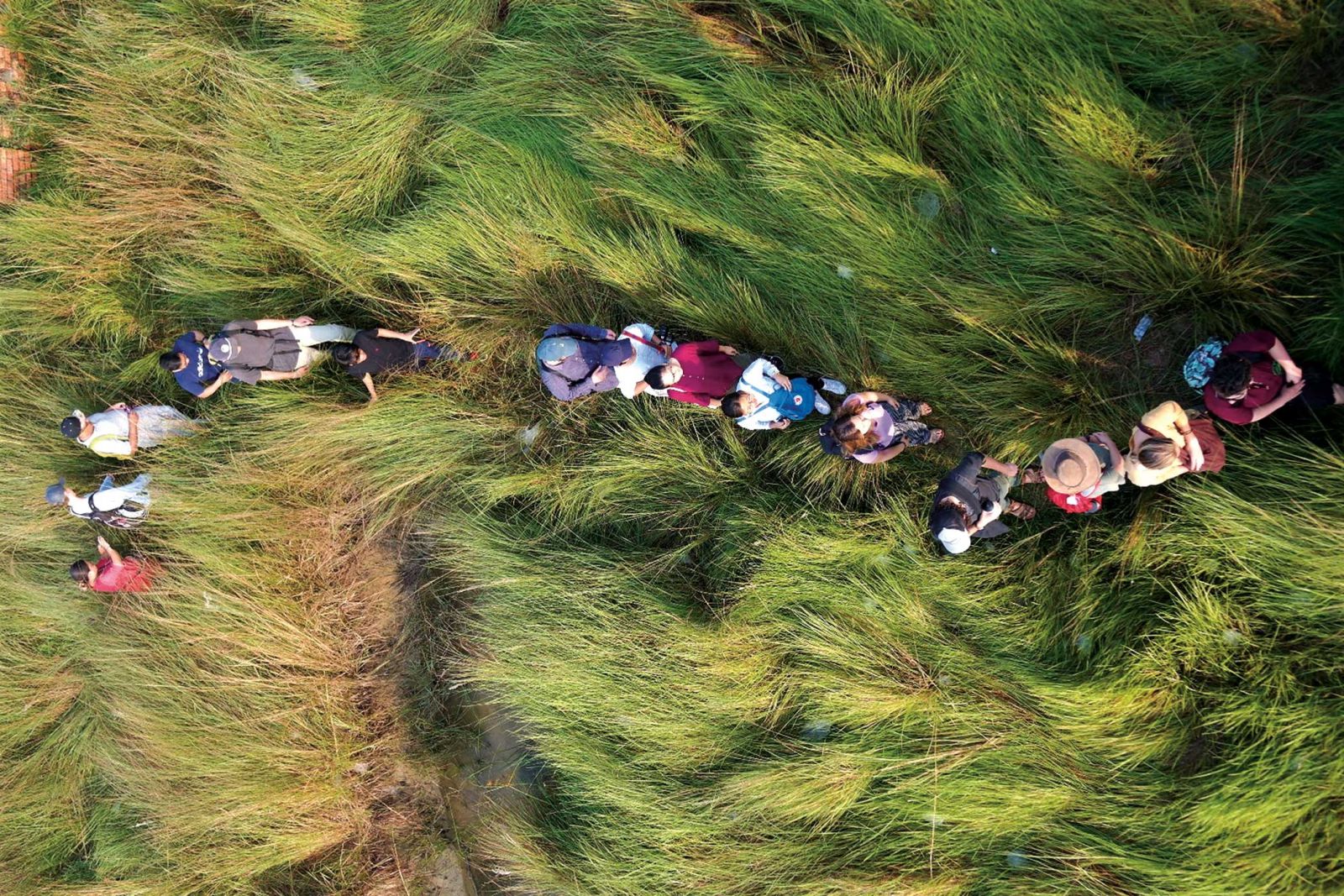.jpg) The slogan, “Buddha was Born in Nepal”, is proudly displayed on vehicles, stickers, and shirts throughout the country. This past October, I got the chance to visit Lumbini, birthplace of the Buddha, a UNESCO World Heritage Site, and a sacred pilgrimage destination.
The slogan, “Buddha was Born in Nepal”, is proudly displayed on vehicles, stickers, and shirts throughout the country. This past October, I got the chance to visit Lumbini, birthplace of the Buddha, a UNESCO World Heritage Site, and a sacred pilgrimage destination.
After a short plane ride from Kathmandu, we arrived at the Lumbini airport, an area in the southern Terai region of Nepal. It lines the border of India, which you can visit to see the immediate changes between the two countries at only a few feet’s distance. The focus of Lumbini is the sacred gardens, where Buddha is said to be born. Here you can see archaeological findings of the area that revealed things previously unknown about the event, including buildings that date back as early as the sixth century B.C.
Beyond the sacred gardens, the 4.8- by 1.6-kilometer area is split into the Theravada monasteries in the east and Mahayana and Vajrayana monasteries in the west, each of which are paid for and maintained by a different country. I stayed at the Canadian monastery, and my time there overlapped with a short-term residence of young nuns. We ate meals together and hung around the outdoor garden areas while they went in and out of session.
The nuns would practice Buddhist debate every night in small circles throughout the courtyard. In debate, a fundamental part of Tibetan Buddhist learning, a natural phenomenon is focused on, and defensible arguments are created against possible misconceptions about it. Through hand clapping, gestures, and loud assertions, the nature of reality is worked on and revealed.
The Lumbini site is split by a canal that dramatically pans between the two main monuments: the Eternal Peace Flame and the Peace Pagoda. Motorboats give tours down the canal, and tuk tuks are also easily available. I cheaply rented a bike for the day, and used it to go beyond the designated site into the surrounding villages. (“Beyond Buddha’s Birthplace”, published by ECS Nepal in July 2018, covers other things to do in this area: http://ecs.com.np/history/beyond-buddhas-birthplace)
 Kenzo Tange, a famous Japanese architect, created the Lumbini Master Plan in 1978. The plan is in the process of completion, as many monasteries are still being constructed. When Tange conceived the plan, he envisioned leaving 60 percent of the land as nature preserve to reflect Buddha’s teachings on the harmony between humans and nature. However, the rising number of visitors has prioritized the push for continuous development over the wellbeing of local wildlife.
Kenzo Tange, a famous Japanese architect, created the Lumbini Master Plan in 1978. The plan is in the process of completion, as many monasteries are still being constructed. When Tange conceived the plan, he envisioned leaving 60 percent of the land as nature preserve to reflect Buddha’s teachings on the harmony between humans and nature. However, the rising number of visitors has prioritized the push for continuous development over the wellbeing of local wildlife.
Lumbini has a high amount of biodiversity and is a designated Important Bird Area (IBA) of Nepal. One species whose habitat has been particularly strained by development is the Sarus crane, the tallest flying bird in the world.
On one early morning, I met with Dharmendra Pal, the program coordinator for the Lumbini Crane Sanctuary. Located in the area surrounding the Peace Pagoda (one of the only two in Nepal; the other is in Pokhara), the 254 acres are part of a 50-year-lease between the International Crane Foundation and Lumbini Development Trust (LDT). Dharmendra led me through the towering grass toward a viewing platform, which we climbed a steep staircase to get onto. From there, we could see across the natural wetlands, where additional ponds have been built to make the ideal habitat for the cranes to mate, hatch, and raise chicks.
The view is refreshing. Almost entirely untouched by construction, you are able to see the natural beauty of Lumbini at its best. A few unattractive structures, however, for possible development of the space, reveal the likely future for the sanctuary. Competing interests and lobbyists want to use the space for further commercial development. Transforming the sanctuary into an area of hotels, or for a giant meditation center or shopping mall, would be devastating to the Sarus crane. They live in pairs and only have one baby annually, and are essential to the local ecosystem. Local farmers try to make nesting areas for the cranes, as they eat insects that destroy crops.
 Peering through Dharmendra’s binoculars, I was able to spot two bright red bobbing heads, highlighted by the early morning sun, of a pair of cranes weaving their chick between the tall grass. Over five feet tall, the majestic bird is breathtaking to witness. Due to habitat destruction, pesticides leaching into their food chain, thinner egg shells leading to a lower hatching rate, and electrocution from flying into power transmission lines, the birds are critically endangered in this area.
Peering through Dharmendra’s binoculars, I was able to spot two bright red bobbing heads, highlighted by the early morning sun, of a pair of cranes weaving their chick between the tall grass. Over five feet tall, the majestic bird is breathtaking to witness. Due to habitat destruction, pesticides leaching into their food chain, thinner egg shells leading to a lower hatching rate, and electrocution from flying into power transmission lines, the birds are critically endangered in this area.
Dharmendra told me the story of the Sarus crane intertwining with that of the Buddha. It is said that the young Siddhartha Gautama and his cousin Devadatta were exploring the gardens behind the palace when a large, low-flying crane caught their attention. When Devadatta shot the bird with an arrow, it took refuge by the young Buddha-to-be, who calmed the bird by tending to the wound. Devadatta argued with his cousin, saying the bird belonged to him, because he had the right to hunt it. Siddhartha refused, saying that because the bird had not yet died and was seeking protection, it was his right to take care of it.
Siddhartha’s father, the king, took the moral issue to the court. After a three-hour discussion, the court came to the conclusion: “The right to life belongs to those who want to preserve it, not to those who want to destroy it. That is the very definition of life. Only when you preserve it you have life. Otherwise, when you destroy it, you have no life.” Buddha’s fight to save the Sarus crane continues today. Unfortunately, in wake of the past civil conflict in Nepal, the International Crane Foundation has been mostly hands off with aid for the area.
Venerable Metteyya Sakyaputta, a Buddhist monk and scholar, grew up in a small village in Lumbini. He has directed the environmental management and education of the area since his time as a young student volunteer at the sanctuary. Recently, Venerable Metteyya was appointed Vice Chairman of the Lumbini Development Trust (LDT). As a passionate advocate for the cranes, his involvement gives hope for their future.
 Venerable Metteyya is an extremely intelligent and impressive young activist, fueled with a deep love for the environment and how Buddha’s teachings integrate within it. During my time in Nepal, the opportunity to speak with him was a top highlight. Lillian Ball—artist, Buddhist practitioner, and environmentalist—was similarly inspired by Venerable Metteyya and his work. Ball specializes in working with water systems, and went to Lumbini to look at the wetlands. But, after meeting Venerable Metteyya, she decided to start shooting clips on her iPhone of their conversations.
Venerable Metteyya is an extremely intelligent and impressive young activist, fueled with a deep love for the environment and how Buddha’s teachings integrate within it. During my time in Nepal, the opportunity to speak with him was a top highlight. Lillian Ball—artist, Buddhist practitioner, and environmentalist—was similarly inspired by Venerable Metteyya and his work. Ball specializes in working with water systems, and went to Lumbini to look at the wetlands. But, after meeting Venerable Metteyya, she decided to start shooting clips on her iPhone of their conversations.
These fused into a documentary that tells the story of the crane sanctuary, with the hope of spreading word about the habitat destruction in Lumbini. Sanctuary, which is fiscally sponsored by The Buddhist Film Foundation, is being screened in several cities to raise awareness. Lillian Ball returned to Nepal, from her base in New York, to work on a second part for the film, as Venerable Metteyya creates an environmental management plan for Lumbini. She also works with local women, who take invasive plant species out of natural areas throughout Nepal to weave into baskets or Buddhas. They are working together to launch the crane sanctuary as an educational nature center for visitors, a new phase of Metteyya’s vision.
“As Buddhists, we put so much money into concrete buildings. We don’t do any nature conservation,” said Venerable Metteyya, who believes the story of the crane could inspire visitors to learn something from the Buddha, in his birthplace. “Take one hour, walking in nature, have some meditation, spot some birds, and very slyly, educate them about climate change. Bring them to [this] place and ask, how are you going to contribute in taking care?” The Buddha’s teaching is compassion, and applied Buddhism puts compassion in action. Metteyya and Ball practice this by showing how Buddhism and conservation can work together to protect the Sarus cranes, and the earth as a whole.
I encourage you to use your power as a tourist to leave a positive impact in Lumbini by exploring and supporting the crane sanctuary, to discourage further development in the area. The future of the Sarus crane in Nepal depends on it.











